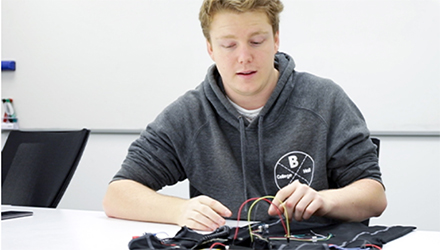
Dr Judy Bowen and Associate Professor Annika Hinze, computer scientists at the University of Waikato and Professor Rangi Matamua from the Faculty of Māori and Indigenous Studies are devising a technological way to keep forestry workers safer on the job. They are developing methods that, for example, will tell workers when they are becoming tired, or are dehydrated. Source: Timberbiz
So far, a shirt with sensors, a smart shirt, is looking like the best option. The project has been going for a couple of years.
An earlier study helped them learn what the influencing factors were that can affect worker performance and which led to their environment being less safe.
Late last year the researchers received MBIE Smart Ideas funding to extend their project to also consider indigenous data sovereignty for the personal data being collected. This is particularly relevant as a large number of forestry workers are Māori.
With exceptional help from Nik Jessop from WorkSafe New Zealand, they’ve been holding talks in Northland with workers from Lloyd Logging, Johnson Training Services Ltd and Ngati Hine Forestry Trust.
These are facilitated by Erina Korahina from the Centre for Health in Tauranga, and involve talking with workers and their whānau and running design activities with them in what’s called participatory design.
The sort of information the researchers needed centred on personal data. For example, they need to know what information were people prepared to give about themselves to a technology solution. How then would they like to receive information about themselves from the technology, who should receive it and how often, and then, once the technology became available, how would they want to respond to it and how much detail should the data provide?
“It’s what they’ll be comfortable with, making them understand that it’s different from off-the-shelf measurement devices,” Dr Bowen said.
“We’re not taking their data and handing it on to anyone else.”
Dr Bowen said the team wanted everyone to feel comfortable about taking part in the design process, so instead of the workers having to reveal information about themselves, the team created personas for them to think about.
“Participatory design makes sure the end users have input into what is being created, so part of it is about framing questions around what’s meaningful, has relevance,” she said. “It’s not like working in a lab. We’re designing for an uncontrolled environment. In the forest the data’s noisy, bits of it can drop out, and people do unexpected or unpredictable things.
“The technology can break. It’s a big challenge, but it’s a great project because it’s got all these moving parts.”
Four honours students are working on aspects of the project including Dylan Exton who is working on creating a smart shirt; a shirt with sensors.
“I’m looking at the best places to put sensors on the garment. Say across the chest to measure heart-rate variability, across the back for perspiration. And you’ve got to make it comfortable and non-intrusive for anyone who wears it. You’ve also got to ensure the sensors are chargeable,” he said.
“Right now, I have a mess of wires, but in the coming weeks I’ll be plugging them into the computer to see how they behave.”
Mr Exton took on the challenge of making a prototype shirt as he likes the combination of software and hardware required for the project.
A postdoctoral fellow has also been taken on to look at managing and understanding the data streams as they come from workers and the environment to work out how best to analyse it.
“How do we come up with an alarm that signals ‘you’re tired, you’re dehydrated’ from the combination of streaming data?” Dr Bowen said. “There’s a lot of complex data processing that has to happen as these smart shirts are going to be worn every working day and will produce continuous data.”





